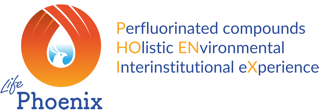Persistent, mobile, toxic and very persistent, very mobile (PMT and vPvM) substances under REACH: a report on the UBA workshop - Life Phoenix

The German Environment Agency (UBA) and the Norwegian Geotechnical Institute (NGI) hosted a workshop on "PMT and vPvM substances under REACH" in Berlin, Germany on the 13-14th of March, 2018. Over 120 people from 16 countries attended, including dr. Sara Valsecchi from IRSA-CNR, partner of the LIFE PHOENIX project. The UBA has proposed criteria and an assessment procedure to identify Persistent, Mobile, Toxic and very Persistent, very Mobile substances that pose a hazard to the sources of drinking water, and invited the chemical industry, drinking water suppliers and regulatory bodies to participate in a discussion of voluntary measures and regulatory options to protect the sources of drinking water.
The criteria proposed by UBA in the assessment of REACH substances are:
- P/vP: Persistence is defined in REACH Annex XIII in the context of PBT/vPvB substances.
- M/vM: Mobile/(very mobile) substances are defined as having a lowest log Koc < 4.0/(3.0) over the environmentally relevant pH range of 4-9; or in the absence of log Koc data, having a lowest log Dow < 4.0/(3.0).
- Toxicity: the T criteria controversially does not correspond with the definition of T as defined in REACH Annex XIII in the context of PBT/vPvB substances. It starts with the NOEC/EC10, CMR, and STOT criteria laid out in Annex XIII, but extends the definition to also include: a) carcinogenic category 2 and germ cell mutagenic category 2; b) additional category for effects on or via lactation; c) derived-No-Adverse-Effect-Level (DNEL) is < 9 u.g/kg/d (oral, long term, general population); d) endocrine disruptor criteria.
- vPvM and not T: 30 substances
- vPvM and PMT: 23 substances
- PMT (but not vPvM): 35 substances
- High Potential to be PMT/vPvM: 152 substances
Discussion between industry and regulatory bodies regarding the equivalency of mobility in PMT with bioaccumulation in PBT was very lively: the concentration of PB substances in the food chain or the concentration of PM substances in the environment from which we and other critical species get drinking water lead to the same result, exposure by the oral intake pathway to concentrations of chemicals that may pose a risk.
The project LIFE PHOENIX partnership contributed to the discussion sharing his experience in managing a critical case study of pollution from a class of vPvM substances, i.e. short chain perfluorinated compounds.
Questo sito fa uso di cookie (tecnici e analitici ad essi assimilabili) per migliorare l'esperienza di navigazione degli utenti e per raccogliere informazioni sull'utilizzo del sito stesso. Oltre ai precedenti il presente sito contiene componenti di terze parti (Facebook, Twitter, Google) che utilizzano cookie di profilazione a scopi pubblicitari per i quali e' necessario prestre il consenso. Proseguendo nella navigazione nel sito si accetta l'uso di tutti i cookie di terze parti precedentemente elencati.

